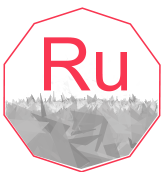Ruthenium

Ruthenium (Ru)
General Information
- Symbol: Ru
- Atomic Number: 44
- Atomic Weight: 101.07 u
- Element Category: Transition metal
- Group: 8
- Period: 5
- Block: d-block
Physical Properties
- Appearance: Silvery-white metallic
- Density: 12.37 g/cm³
- Melting Point: 2334 °C (4233 °F)
- Boiling Point: 4150 °C (7502 °F)
- Phase at STP: Solid
- Electron Configuration: [Kr] 4d⁷ 5s¹
- Oxidation States: +8, +6, +4 (most common), +3, +2, +1, -2
Chemical Properties
- Reactivity: Resistant to corrosion and oxidation, reacts with halogens and acids at high temperatures.
- Compounds: Forms compounds such as ruthenium dioxide (RuO₂), ruthenium tetroxide (RuO₄), and various organometallic compounds like ruthenocene (Ru(C₅H₅)₂).
Uses and Applications
- Catalysts: Widely used as a catalyst in chemical reactions, including in the petrochemical industry and in the production of ammonia.
- Electronics: Utilized in chip resistors and electrical contacts due to its durability and conductivity.
- Jewelry: Occasionally used in platinum alloys to improve hardness.
- Medicine: Investigated for use in cancer therapy and as a component in some chemotherapy drugs.
- Solar Cells: Used in dye-sensitized solar cells (DSSCs) as a photosensitizer.
Occurrence and Extraction
- Natural Occurrence: Found in ores with other platinum group metals, primarily in the minerals laurite (RuS₂) and osmiridium.
- Extraction: Extracted from platinum ores through a series of chemical processes including dissolution, precipitation, and purification.
Isotopes
- Stable Isotopes: Ruthenium-96, Ruthenium-98, Ruthenium-99, Ruthenium-100, Ruthenium-101, Ruthenium-102, Ruthenium-104
- Radioactive Isotopes: Ruthenium-106 (used in cancer treatment)
Safety and Handling
- Hazards: Some ruthenium compounds, such as ruthenium tetroxide (RuO₄), are highly toxic and can be volatile.
- Precautions: Handle with care in a well-ventilated area, using appropriate protective equipment.
History
- Discovery: Discovered by Karl Ernst Claus in 1844.
- Name Origin: Named after Ruthenia, the Latin name for Russia.
Additional Facts
- Crystal Structure: Hexagonal close-packed (hcp)
- Magnetic Properties: Paramagnetic
- Thermal Conductivity: Moderate, about 117 W/m·K
- Electrical Resistivity: About 71 nΩ·m at room temperature
Summary
Ruthenium is a transition metal known for its excellent catalytic properties, corrosion resistance, and conductivity. It has diverse applications in catalysis, electronics, jewelry, medicine, and solar cells. Found primarily in ores with other platinum group metals, ruthenium is extracted through complex chemical processes. Its stability and unique properties make it valuable across multiple industries.
What is the atomic number of Ruthenium?
- 44
What is the symbol for Ruthenium?
- Ru
What is the atomic weight of Ruthenium?
- 101.07 u
In which group of the periodic table is Ruthenium found?
- Group 8
What period is Ruthenium in?
- Period 5
What block does Ruthenium belong to?
- d-block
What is the melting point of Ruthenium?
- 2334 °C (4233 °F)
What is the boiling point of Ruthenium?
- 4150 °C (7502 °F)
What is the density of Ruthenium?
- 12.37 g/cm³
What is the electron configuration of Ruthenium?
- [Kr] 4d⁷ 5s¹
What are the common oxidation states of Ruthenium?
- +8, +6, +4 (most common), +3, +2, +1, -2
What is the appearance of Ruthenium?
- Silvery-white metallic
Is Ruthenium reactive with halogens?
- Yes, at high temperatures
Name a compound of Ruthenium.
- Ruthenium dioxide (RuO₂)
What is a common use of Ruthenium in the chemical industry?
- As a catalyst in chemical reactions
How is Ruthenium used in electronics?
- In chip resistors and electrical contacts
What role does Ruthenium play in jewelry?
- Used in platinum alloys to improve hardness
How is Ruthenium used in medicine?
- Investigated for cancer therapy and chemotherapy drugs
What solar technology uses Ruthenium?
- Dye-sensitized solar cells (DSSCs) as a photosensitizer
Name a mineral that contains Ruthenium.
- Laurite (RuS₂)
How is Ruthenium extracted from ores?
- Through chemical processes including dissolution, precipitation, and purification
What is the most stable isotope of Ruthenium?
- Ruthenium-102
Name a radioactive isotope of Ruthenium used in medicine.
- Ruthenium-106
What safety hazard is associated with Ruthenium tetroxide (RuO₄)?
- It is highly toxic and volatile
Who discovered Ruthenium?
- Karl Ernst Claus
Where does the name Ruthenium come from?
- From Ruthenia, the Latin name for Russia
What is the crystal structure of Ruthenium?
- Hexagonal close-packed (hcp)
Is Ruthenium paramagnetic or diamagnetic?
- Paramagnetic
What is the thermal conductivity of Ruthenium?
- About 117 W/m·K
What is the electrical resistivity of Ruthenium at room temperature?
- About 71 nΩ·m
What is the primary oxidation state of Ruthenium?
- +4
Is Ruthenium found as a free element in nature?
- No, it is found in ores with other platinum group metals
What is the common name of ruthenium tetroxide?
- Ruthenium(VIII) oxide
What is a major application of Ruthenium dioxide (RuO₂)?
- Used as a catalyst in chemical reactions
How does Ruthenium improve platinum alloys?
- By increasing hardness
What is the boiling point of Ruthenium in Kelvin?
- 4423 K
What group does Ruthenium belong to in the periodic table?
- Transition metals
What is the natural abundance of Ruthenium-102?
- About 31.6%
Can Ruthenium be used in high-temperature applications?
- Yes, due to its high melting point
What is the key property that makes Ruthenium valuable in catalysis?
- Its excellent resistance to corrosion and oxidation.






